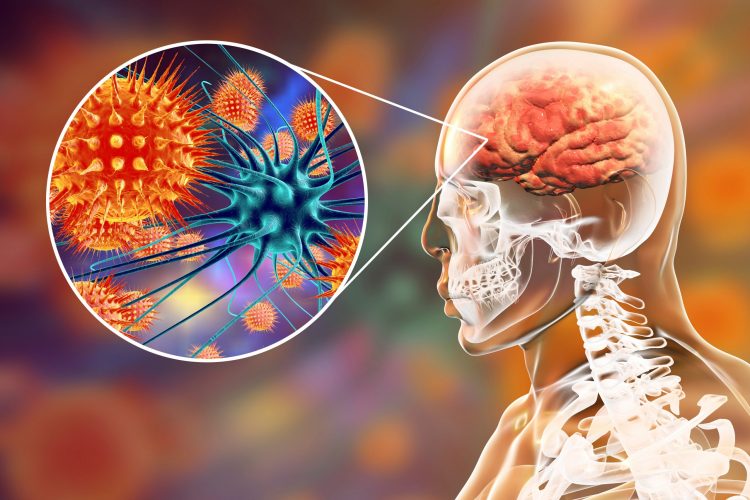Understanding infection and inflammation of central nervous system in children is essential for recognising symptoms early and ensuring timely intervention. Delayed recognition and treatment of infection and inflammation of central nervous system can lead to serious health consequences. By learning more about infection and inflammatory disorders in children, parents and caregivers can be better equipped to recognise warning signs and seek appropriate medical care.
What is Encephalopathy?
- Encephalopathy is a syndrome of altered consciousness
- Many causes, such as infections, metabolic alterations, etc.
What is Encephalitis?
- Encephalitis means inflammation of the brain tissue.
- Causes may include viruses, bacterias or parasites, or immune mediated phenomenon.
- While less common in children than in adults, these disorders can still have serious consequences and require prompt medical attention.
What are the important signs and symptoms of encephalitis?
Classical presentation:
- Febrile illness with severe headache, altered consciousness
- With or without seizures
- Presentation can be subtle and fluctuant
- Lethargy/ drowsiness
- ‘No clear source of infection’
What are the types of Viral CNS infection?
1. Viral Meningitis
- Inflammation of meninges (lining of the brain)
- Associated with headache, vomiting, photophobia (sensitive to bright light), neck stiffness, high white cells in cerebrospinal fluids (CSF).
2. Viral Encephalitis
- Viral invasion and inflammation of brain tissue
- Behavioural change, confusion, ’psychiatric illness’, coma, seizures, focal signs (such as weakness of one side of the body.)
3. Viral Myelitis
- Inflammation of spinal cord
- Flaccid limb paralysis (limb weakness), absent deep tendon reflexes
What is Herpes Simplex Virus (HSV) encephalitis?
- 1-2 cases per 250,000 population, annually
- Most infection is due to HSV Type 1 via oral transmission
- 10% is due to HSV Type 2 via genital transmission.
- More often it causes meningitis; but it can cause encephalitis in immunocompromised children and adults
What Are the Signs and Symptoms of HSV Encephalitis in Children?
Recognising the signs and symptoms of HSV encephalitis in children is crucial for prompt medical attention and intervention. Here are common indicators to watch for:
1. Fever & Exposure to HSV
2. Hemiparesis/ Motor Weakness
Motor weakness, especially on one side of the body (hemiparesis), can be a sign of encephalitis. Children may have difficulty moving an arm or leg, or they may complain of tingling sensations.
3. Dysphasia (Difficulty Speaking or Understanding)
Children may have trouble speaking or understanding language. They may slur their words, have difficulty finding the right words or struggle to comprehend spoken or written language.
4. Focal Seizures
Seizures can manifest as convulsions, twitching, or staring spells.
How Are HSV Encephalitis in Children Diagnosed?
Diagnosing viral encephalitis or HSV encephalitis in children involves a evaluation by paediatric neurologist or paediatrician, including a detailed medical history, physical examination, neurological assessment, and imaging studies such as MRI or CT scans.
A procedure called lumbar puncture (spinal tap) will be carried out to check for signs of infection in the brain or spinal cord. The fluid collected from the lumbar puncture (LP) – Cerebrospinal Fluid (CSF) will be analysed for the DNA fragments of viruses, including HSV, VZV (chickenpox), Enteroviruses.
Neuroimaging can be helpful in HSV encephalitis. Early CT Head may show area of inflammation/ infection and brain oedema (swelling), but CT head can be negative. MRI brain is recommended as it is more sensitive in picking up abnormal changes than CT head. Abnormal MR brain signals are typically found at front-temporal and parietal regions of the brain.

From: Gaillard F, Sharma R, Glick Y, et al. Herpes simplex encephalitis. Reference article, Radiopaedia.org (Accessed on 06 Apr 2024) https://doi.org/10.53347/rID-1410
Early detection and treatment are critical for optimising clinical outcomes and providing appropriate support for affected children and families.
Why encephalitis is missed in children or adults?
- Wrongly attributed a child’s fever and confusion to an urinary tract infection (based on urine dipstick) or chest infection (based on a few chest signs), without strong evidence.
- Failure to realised that a child has a febrile illness, just because they are not febrile during assessment.
- Ignoring a caregiver’s complaint that a child is ‘not quite right’, sleepy, or lethargic.
- Wrongly attributing clouding of consciousness to drugs or alcohol, without good evidence.
- Failure to properly investigate a child with a fever and seizure, following which they do not recover consciousness
- Failure to do a lumbar puncture even though there are no contraindications.
What Are The Treatment For HSV encephalitis in Children?
HSV encephalitis is more common in children than adults. Treatment for children with HSV encephalitis aim to manage symptoms, prevent complications, and improve long-term outcomes.
Medication
Anti-viral therapy, such as intravenous Aciclovir, should be started after lumbar puncture or if CSF is consistent with viral encephalitis. If lumbar puncture is not possible, it is important to treat anyway, especially if brain scan is consistent with viral encephalitis, or there is a strong clinical suspicion. 14-21 days of intravenous Aciclovir is the recommended duration of treatment for HSV encephalitis. However, if intravenous access is not possible, oral valaciclovir may be considered after at least 10 days of intravenous Aciclovir.
Medications may be prescribed to manage symptoms and prevent complications. For example, anti-seizure medications may help control seizures.
Rehabilitation Therapy
Rehabilitation therapy, including physical therapy, occupational therapy, speech therapy, and orthotist plays a crucial role in helping children recover and regain function after brain infection or inflammation. These therapies improve mobility, motor skills, communication, and daily living activities; Appropriate equipments or aids, and orthotic devices can be useful in improving mobility and posture.
Supportive Care
Supportive care measures, including close monitoring, hydration, nutrition support, and management of other medical conditions, are essential for optimising outcomes and preventing complications in children with CNS infections.
Long-Term Follow-Up
Long-term follow-up with paediatric neurologist and allied healthcare providers are essential to monitor the child’s progress, adjust treatment as needed, and address any new or ongoing concerns. Regular evaluations may include imaging studies, neurological assessments, and developmental screenings may be used to track the child’s recovery and outcome measures.
References
Dr Yeo’s recent peer-group review journal publications and abstracts regarding infections and inflammation of Central Nervous System:
Kumar, Pavanish & Lim, Amanda & Hazirah, Sharifah & Chua, Camillus & Ngoh, Adeline & Poh, Su Li & Yeo, Tong & Lim, Jocelyn & Ling, Simon & Sutamam, Nursyuhadah & Petretto, Enrico & Low, David & Zeng, Li & Tan, Eng-King & Arkachaisri, Thaschawee & Yeo, Joo & Ginhoux, Florent & Chan, Derrick & Albani, Salvatore. (2022). Single-cell transcriptomics and surface epitope detection in human brain epileptic lesions identifies pro-inflammatory signaling. Nature Neuroscience. 25. 1-11. 10.1038/s41593-022-01095-5.
Rr, Pravin & Douch, Catherine & Koh, Mark & Lai, Angeline & Lim, Tchoyoson & Hartley, Louise & Thomas, Terrence & Yeo, Tong. (2021). Speckled brain lesions in Incontinentia Pigmenti patients with acquired brain syndromes. European Journal of Paediatric Neurology. 33. 10.1016/j.ejpn.2021.05.012.
Yeo TH, Vassallo G, Judge M, Laycock N, Kelsey A, Crow YJ. Infantile neurological Degos disease. Eur J Paediatr Neurol. 2011 Mar;15(2):167-70.






